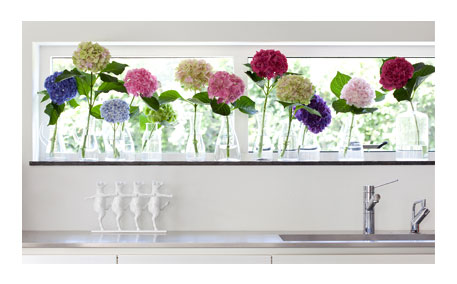This blooming plant is becoming more and more popular among gardeners for the beautiful colours available and even more so among florists who use the plant in summer bouquets. The name ‘hydrangea’ comes from the botanist Grovonius who associated in 1739 two words “hydro” (water) and “angeion” (pitcher) to create the name Hydrangea. This botanist was fascinated by the shape of this flower believing that it looked like an ‘old water jug’.
These large colorful flowers can grow anywhere and everywhere, and beautifully decorate large planters and terraces. Even though the hydrangea enjoys a mild climate, with the minimum of care (mulching and protective film), this plant can withstand the coldest winters. It is also recommended to keep the faded flowers until March because they act as a natural protection against freezing. Then in spring you can cut them and add fertilizer to begin the cycle again.
A unique aspect of the hydrangea is the evolution of color during flowering. Naturally pink, white or red, the color of the flowers color is influenced by the soil that hosts the plant. In an acidic soil, the flowers develop a deep blue color. The more acidic and richer in iron sulphate the soil is, the darker the color becomes. By adding broken slate in the earth, this effect even is accentuated. In autumn, the color ends with a dark red combination typical of that season, both for flowers and leaves. A garden with different colors of hydrangea may look like a real painter's palette and over the years it is not uncommon that the original colors change as well. A pale pink hydrangea can whiten or turn red according to soil and fertilizer. The growth of the hydrangea is fast and they quickly provide a mass effect with very significant colors. Except intensive water care during summer, hydrangeas do not require any special care.
You can enjoy the flowers directly in the garden but solid hydrangea “heads” or “balls” are also superb in a vase. A hydrangea bouquet of various colors brings an immediate feeling of freshness in the house. And for those who want to enjoy even longer, hydrangea balls are very easy to dry. To do this simply remove the leaves and hang upside down. You can also place the stem in a vase with a little quantity of water to the dry flower gradually and slowly. This craze for hydrangea is also confirmed in flower shops. Florists like to use the hydrangea as a cut flower in bouquet or arrangement combining them with fresh and stunning creation. For those who are not lucky enough to have a garden or a balcony, it is a simple way to enjoy this flower almost all year round.
If you are unable to visit a flower shop or want to surprise someone with a colorful and fresh hydrangea, send flowers. This summer, the hydrangea is the perfect gift to make someone very happy, loved and remembered with flowers!





